Maureen Lang's Blog, page 22
April 25, 2011
Boundaries of Your Element

@font-face { font-family: "Cambria"; }p.MsoNormal, li.MsoNormal, div.MsoNormal { margin: 0in 0in 10pt; font-size: 12pt; font-family: "Times New Roman"; }div.Section1 { page: Section1This was the state of my yard only about a week ago — an inch and a half of lovely, white snow. Of course, the truth is April snow is almost never considered lovely—unlike December snow when everyone welcomes wintry weather with songs like White Christmas or Winter Wonderland. Only one thing makes April snow bearable: it rarely lasts.
 When I took the picture of my snow-laden daffodils I recall thinking how out of their element they seemed. Their very yellow screams spring and sunshine. It doesn't seem as though they should be able to survive temperatures cold enough for snow, does it?
When I took the picture of my snow-laden daffodils I recall thinking how out of their element they seemed. Their very yellow screams spring and sunshine. It doesn't seem as though they should be able to survive temperatures cold enough for snow, does it?
I remember one year I planted my annuals a little too early, having been fooled into believing winter was behind us because of a string of warm days. But a May frost killed nearly all of my pretty begonias and impatiens. They truly were out of their element. A bit like Paul Newman in The Silver Chalice (a movie I'd been lucky enough never to have seen until this weekend), or birds that somehow find their way inside shopping malls. Or me on a dance floor. Or aboard a ship. Or, any more, in a tent. (I guess my element is more limited as I age. Roller coasters seem to be off limits to me now that I'm older, too, but I'm digressing.)
 Here's my daffodils again. This picture was taken a few days later, once the sun finally returned and we bid even the snow hiding in chilly shadows a happy adieu. Other than a few flowers still bending low, you'd never know most of them shivered under the white stuff only hours before.
Here's my daffodils again. This picture was taken a few days later, once the sun finally returned and we bid even the snow hiding in chilly shadows a happy adieu. Other than a few flowers still bending low, you'd never know most of them shivered under the white stuff only hours before.
I knew not to worry about my daffodils, really, because they come up every year under God's direction. He knows which plants can handle overlapping seasons. And that, of course, reminded me that certain flowers—daffodils and pansies, for example—are a lot tougher than they look, at least with the cold. The boundary of their element might be wider than you'd think with a glance.
I don't know why it's considered an insult to call someone a pansy, since like my daffodils they're tough little buggers. I think when I was younger I was a bit closer to daffodils and pansies than I am these days, with age and a desire for comfort narrowing my boundaries.
I guess it's wise to know our element and recognize when we're not in it anymore. Kind of like Dorothy when she realized she wasn't in Kansas any more. But when we do leave our element, because sometimes we must, we can always remind ourselves of the daffodils. Sometimes God knows our boundaries better than we do. And didn't He leave His element when He came down here from Heaven to cavort with tax collectors and lepers, and headed for the cross?
Next time I'm feeling out of my element, I think I'll remind myself I can surely be as tough as my daffodils.
April 20, 2011
New Fiction Wednesday!
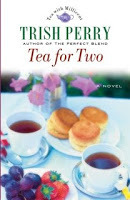
This week I'm glad to welcome back my friend Trish Perry as she talks about her new book and shares a chocolate-lover's recipe just in time for Easter!
About Tea for Two:
Zack Cooper tries his best to raise his children, but he's losing his grip on them in their teen years. They've both had scrapes with the local law.
Tea Shop owner Milly Jewel has the perfect woman in mind to help Zack. Counselor Tina Milano meets weekly at the tea shop with her women's group. Milly encourages Zack and Tina to work together to draw the teens back before they get in even hotter water. Milly never thought things might heat up between Zack and Tina. Or did she?
Tina's connections with the Middleburg police department prove a mixed blessing for Zack and his kids. Both her best friend and old boyfriend are officers on the force.
And when Tina's women's group gets wind of her personal pursuits and clashes, they want to help. The group's meetings at the tea shop take on a slightly different flavor. Tina wonders who, exactly, is counseling whom.
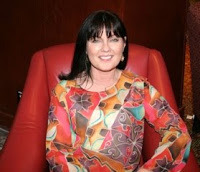 About Trish: Award-winning novelist Trish Perry has written eight inspirational romances for Harvest House Publishers, Summerside Press, and Barbour Publishing, as well as two devotionals for Summerside Press. She has served as a columnist and as a newsletter editor over the years, as well as a 1980s stockbroker and a board member of the Capital Christian Writers organization in Washington, D.C. She holds a degree in Psychology.
About Trish: Award-winning novelist Trish Perry has written eight inspirational romances for Harvest House Publishers, Summerside Press, and Barbour Publishing, as well as two devotionals for Summerside Press. She has served as a columnist and as a newsletter editor over the years, as well as a 1980s stockbroker and a board member of the Capital Christian Writers organization in Washington, D.C. She holds a degree in Psychology.Trish's latest novel, Unforgettable, released in March, and Tea for Two released in April. She invites you to visit her at www.TrishPerry.com
Recipe:
@font-face { font-family: "Courier New"; }@font-face { font-family: "Wingdings"; }p.MsoNormal, li.MsoNormal, div.MsoNormal { margin: 0in 0in 0.0001pt; font-size: 12pt; font-family: "Times New Roman"; }div.Section1 { page: Section1; }ol { margin-bottom: 0in; }ul { margin-bottom: 0in; }
Chocolate Mousse Cake
Ingredients:
6 ounces crushed malt balls
8.8 ounce container mascarpone cheese
7 ounces heavy cream, whipped
3 seven ounce packages white chocolate & Macadamia cookies
1 cup Bailey's Irish cream liqueur (for non-alcoholic version use Irish Crème coffee creamer)
Chocolate mousse:
10 ounces chopped dark chocolate
2 eggs (room temperature)
¼ cup caster sugar (very fine granulated sugar)
¾ cup heavy cream, whipped
Directions:
Make chocolate mousse—
In microwave-safe bowl, microwave chopped chocolate until almost melted, stirring after each minute. Set aside to cool slightly.Beat eggs and caster sugar with electric beater for five minutes.Stir in cooled chocolate.Fold in ¾ cup whipped cream. Refrigerate until needed.
Set aside ¼ cup crushed malt balls.
Fold together mascarpone, 7 ounces whipped cream, and remaining malt balls. Remove the base of an 8-inch spring form pan and place the ring on a large serving plate (ring will serve as a mold for the cake). Cut a strip of parchment paper and line side of ring. Dip cookies, one at a time, into liqueur and place in single layer in mold to cover base. Spread half mascarpone mixture over cookies. Top with another layer of cookies dipped in liqueur.
Spread chocolate mousse over cookies. Top with one more layer of cookies dipped in liqueur. Spread remaining mascarpone mixture over cookies and sprinkle with the ¼ cup reserved malt balls.
Cover and refrigerate overnight. Then remove spring form, peel away parchment paper, cut, and serve.
April 18, 2011
Screen Size

@font-face { font-family: "Cambria"; }p.MsoNormal, li.MsoNormal, div.MsoNormal { margin: 0in 0in 10pt; font-size: 12pt; font-family: "Times New Roman"; }div.Section1 { page: Section1; Over the weekend my husband and I went to the movie theater. We saw Win Win, which was entertaining apart from the bad language, but that's not what this blog posting is about. While we waited for the show to begin, we chatted in the dim lighting and stared at the big, blank screen before us. Because of how much my husband enjoyed watching a sporting event on our big screen television the night before, he wondered if theaters like the one we were in might be losing business because of home theaters, Netflix, Redboxes, etc. As he often does when he thinks I'm about to disagree with something, he pushed it a bit farther – offering a teasing guess about how movie theaters would be a thing of the past before long. But even with surround sound, blue ray technology and the comfort of home, there is still something uniquely enjoyable about going out to see a new movie on a really big screen, as our presence there proved.
His point, though, wasn't so much about the competition of home theaters vs. movie theaters as how watching such a thing on our little screen in the kitchen wouldn't compare to either experience. The difference, he said, was so vast he thought a person ought to just listen to the radio rather than watch a small screen t.v.
In fact, the only thing bigger than a movie theater screen is the one in our imagination. Remember old time radio? Well, I don't either, other than special programs I went out of my way to find. That forum didn't limit the listener's images to a screen, just as when we're reading a good book or listening to one on audio we're part of the story. We're there. We're not just viewing it in front of us, we're drawn in and it's alive in the endless dimension of our mind. Our interpretation includes every detail drawn by a skillful writer.
Which is probably why so many people are disappointed in movies after they've read the book version. I wanted to see Water for Elephants with my daughter, but she hasn't yet read the book (imagine that—I've actually read something she hasn't!) but agreed to put it off another week or so to wait for her. Reading a book after seeing the movie version might limit the screen in her head. Worse, if the movie took liberties because of the confinements of filming, it's the book that's right (if that's the original resource for the story) and so she wants to experience that first.
 All this to say movie theaters do have a place in entertainment, and the size of a screen matters, but books don't limit the experience so that works best for me. Conclusion: take a part of your day and enjoy a good book.
All this to say movie theaters do have a place in entertainment, and the size of a screen matters, but books don't limit the experience so that works best for me. Conclusion: take a part of your day and enjoy a good book.
April 13, 2011
New Fiction Wednesday
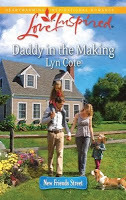
Daddy in the Making
2nd in New Friends Street series
by Lyn Cote
ISBN-13:978-0-373-87663-1
Harlequin Love Inspired Romance
Released Apr 2011
Here's a little about the book:
Brought together by a Matchmaking Dog--
Dr. Jake McClure's basset hound has fallen in love. With a single mom, her adorable twins and the orphaned kittens they rescued. Man's best friend suddenly won't budge from Jeannie Broussard—and Jake can understand why. Jeannie is full of love, laughter and everything Jake has been missing in his life lately. As Jake spends time with Jeannie and her girls helping to build her Habitat for Humanity house and rescuing stray animals, a bond forges between them, and soon Jake is wondering if he's the perfect fit in this fatherless family....
To purchase, drop by http://booksbylyncote.com/SWBS/
New Friends Street:
Where love and dreams find a home.
About Lyn:
 When Lyn Cote became a mother, she gave up teaching, and while raising a son and a daughter, she began working on her first novel. Rejection followed. Finally, Lyn got "the call." Her first book, Never Alone, was chosen for the new Love Inspired romance line. Since then, Lyn has had over thirty novels published. In 2006 Lyn's book, Chloe, was a finalist for the RITA, one of the highest awards in the romance genre. And her Her Patchwork Family was a Carol finalist in the short historical category in 2010. Lyn's brand "Strong Women, Brave Stories," always includes three elements: a strong heroine who is a passionate participant in her times, authentic historical detail and a multicultural cast of characters. Lyn also features stories of strong women both from real life and true to life fiction on her website homepage, http://www.LynCote.net. Lyn also can be found on Facebook, Twitter and Goodreads. Drop by and "friend or follow" her. Now living her dream of writing books at her lake cottage in northern Wisconsin, Lyn hopes her books show the power of divine as well as human love.
When Lyn Cote became a mother, she gave up teaching, and while raising a son and a daughter, she began working on her first novel. Rejection followed. Finally, Lyn got "the call." Her first book, Never Alone, was chosen for the new Love Inspired romance line. Since then, Lyn has had over thirty novels published. In 2006 Lyn's book, Chloe, was a finalist for the RITA, one of the highest awards in the romance genre. And her Her Patchwork Family was a Carol finalist in the short historical category in 2010. Lyn's brand "Strong Women, Brave Stories," always includes three elements: a strong heroine who is a passionate participant in her times, authentic historical detail and a multicultural cast of characters. Lyn also features stories of strong women both from real life and true to life fiction on her website homepage, http://www.LynCote.net. Lyn also can be found on Facebook, Twitter and Goodreads. Drop by and "friend or follow" her. Now living her dream of writing books at her lake cottage in northern Wisconsin, Lyn hopes her books show the power of divine as well as human love.
One of the secondary characters in this book, Millie, is famous for her Baked Macaroni and Cheese. Here's my recipe.
Lyn Cote's Baked Macaroni
I adapted this recipe from my 1940 Better Homes and Gardens Cookbook. I've cut the fat content from the original and changed to whole wheat or SMART TASTE macaroni to up the fiber. So you can indulge with this recipe, knowing that it's healthy!
1 lb. whole wheat macaroni or Ronzoni Brand Smart Taste pasta (fortified with Calcium, Vitamin d and Fiber)
****
White sauce:
6 Tb butter or margarine
¾ c. flour
5 c. skim milk
¾ tsp salt
¼ tsp pepper
*****
1 lb grated medium cheddar cheese (Or if you want to give this a Mexican flavor, substitute pepper jack cheese.)
1 c. bread crumbs (or crushed tortilla chips)
Cook macaroni, drain and put into greased, deep casserole dish or bowl. Make the white sauce and take pan off heat (to keep the cheese from becoming stringy). Add 2/3rd's of the grated cheese. Stir till melted. Pour over macaroni. Sprinkle remaining cheese and bread crumbs over top. Bake at 350 F for 30 minutes. May serve as side dish or main course.
Drop by http://www.LynCote.com to learn more about Lyn's literary concoctions. And catch up on her free read, La Belle Christiane, an original manuscript never published, a new scene every Monday, Wednesday and Friday.
April 11, 2011
How do you justify art?
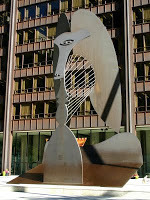
@font-face { font-family: "Cambria"; }p.MsoNormal, li.MsoNormal, div.MsoNormal { margin: 0in 0in 10pt; font-size: 12pt; font-family: "Times New Roman"; }div.Section1 { page: Section1; }I recently participated in a conversation where the topic went to the value of art. One way of looking at art is similar to the garage-sale justification: one person's trash is another's treasure. Taste in art can be so subjective. Take a Picasso, for example. I live in the Chicago area where everyone knows the landmark sculpture in Daley Plaza. Over the years I've heard it called all kinds of things, from majestic to a dog to a silly looking baboon to Huh? What's that?
There is more traditional art, of course, where the artist's rendition doesn't take quite so much effort to interpret. Personally, that's the kind I enjoy, but then I've been called pedestrian before and not been offended.
I don't want to get political and discuss where public funding should be cut from which art programs. Instead, I just want to glance at this topic out of pure curiosity. As a writer who sometimes feels guilty for accepting money for writing stories that are pure pleasure to create, I also realize the value of writing because I enjoy reading. Of all the arts, I often find storytelling to be the most inspirational.
But what, really, is the purpose of art? Is it to enhance life, to inspire, to ease life's pain, to accompany one's joy, to educate, to worship, to condemn, to articulate the human experience? Probably all of that and more.
Once artists start sharing art, no matter what form: paintings or sculpture, photography or music, poetry or prose, at some point it must be assigned worth. In an economy, that comes down to money. Do you assign its value by asking key questions like: How many people will it impact? Will it improve anyone's life? Can art solve a problem? What problem can it solve? Does art ever solve a problem? Can inspiration in one area lead to answers in another? How do you assess quality if that's so subjective?
The best art is inspirational. For me, music can inspire the big picture of an entire plot or it can help me to see a more specific picture of the characters inhabiting that story. Music can define emotions for my characters, helping me to get inside their head and find words to explain motivation, reaction, or goals that might be important in a novel. That's priceless, because it makes my characters—and therefore my stories—come alive for me first, and then hopefully for my readers.
Paintings can inspire me, too. In my current project I'm using a painting I once saw in a museum that depicted Christ crucified between two thieves. It's meant to evoke emotion, and in my heroine—who aspires to be a thief—it stirs a mixed reaction at best. Guilt, of course, but hope for forgiveness. Had I not already seen a painting like the one I'm using in my story, I'm not sure I could capture some of the emotions such a painting can evoke in my character.
On a personal rather than professional level, my life holds just enough challenge to make art something of vital importance to me. I love escaping into a novel, or losing myself in a song, or resting in front of a portrait I find lovely. I'm willing to spend money to do that very thing.
But, like the pricing problem that comes with hosting a garage sale, I find it impossible to put a dollar amount on art. It depends on the perceived quality, on my need, and probably other variables less easily defined. I do know one thing about art, and that by partaking in it we are either consciously or subconsciously emulating our Creator God. If the sun ever emerges again in what has until recently still felt like the dregs of winter, I'll see God paint the sky in colors that can take my breath away. And He'll do it entirely free of charge.
If the sun ever emerges again in what has until recently still felt like the dregs of winter, I'll see God paint the sky in colors that can take my breath away. And He'll do it entirely free of charge.
April 6, 2011
New Fiction Wednesday!
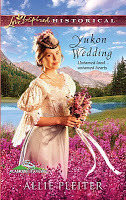 As promised yesterday, I'm introducing a second book this week. Today I'm excited to let you know about my friend Allie Pleiter's brand new book, Yukon Wedding from Harlequin Love Inspired Historicals.
As promised yesterday, I'm introducing a second book this week. Today I'm excited to let you know about my friend Allie Pleiter's brand new book, Yukon Wedding from Harlequin Love Inspired Historicals.Here's a little about the story:
@font-face { font-family: "Georgia"; }@font-face { font-family: "ヒラギノ角ゴ Pro W3"; }@font-face { font-family: "Georgia Bold"; }p.MsoNormal, li.MsoNormal, div.MsoNormal { margin: 0in 0in 0.0001pt; font-size: 12pt; font-family: "Times New Roman"; }p.FreeForm, li.FreeForm, div.FreeForm { margin: 0in 0in 0.0001pt; font-size: 12pt; font-family: "Times New Roman"; color: black; }div.Section1 { page: Section1; }
A gold-rush town is no place for a single mother. But widow Lana Bristow won't abandon the only home her son has ever known. She'll fight to remain in Treasure Creek, Alaska—even if it means wedding Mack Tanner, the man she blames for her husband's death. Mack sees marriage as his duty, the only way to protect his former business partner's family. Yet what starts as an obligation changes as his spoiled socialite bride proves to be a woman of strength and grace. A woman who shows Mack the only treasure he needs is her heart.
About Allie:
An avid knitter, coffee junkie, and devoted chocoholic, Allie Pleiter writes both fiction and non-fiction. The enthusiastic but slightly untidy mother of two, Allie spends her days writing books, buying yarn, and finding new ways to avoid housework. Allie hails from Connecticut, moved to the midwest to attend Northwestern University, and currently lives outside Chicago, Illinois. The "dare from a friend" to begin writing has produced two parenting books, fourteen novels, and various national speaking engagements on faith, women's issues, and writing. Visit her website at www.alliepleiter.com or her knitting blog at www.DestiKNITions.blogspot.com
@font-face { font-family: "ヒラギノ角ゴ Pro W3"; }p.MsoNormal, li.MsoNormal, div.MsoNormal { margin: 0in 0in 0.0001pt; font-size: 12pt; font-family: "Times New Roman"; }p.HeaderFooter, li.HeaderFooter, div.HeaderFooter { margin: 0in 0in 0.0001pt; font-size: 10pt; font-family: "Times New Roman"; color: black; }p.Body, li.Body, div.Body { margin: 0in 0in 0.0001pt; font-size: 12pt; font-family: "Times New Roman"; color: black; }div.Section1 { page: Section1; }
A note from Allie about Yukon Wedding:
The heroine in my latest release YUKON WEDDING lets an object take center stage in her life. She has two brooches that come to mean a whole host of choices she's made. They get her and her new husband, Mack, into some serious trouble. That's not to say tokens and baubles are bad things, but we've all had times when the object itself eclipses the meaning behind it. A little bit too close to the whole "idol" thing.
Now, my kids would probably make some remark right here about how Mom is unnaturally attached to her Blackberry--and they'd be half right. I'm never without the thing, and the one time I lost it I absolutely panicked. My fear, however, was about loss of information and schedules more than the smartphone. It's a means to an end (that end being organization) for me more than a treasured trinket. I hope. I do wonder, sometimes.
What treasures have I let get the best of me? I wear two Pandora bracelets every day because each bead represents a milestone in my life. Would that life go away if I lost them? Would I hesitate if a robber said "your jewelry or your life"? It's interesting to ponder the question. What about my daughter's first teddybear? My father's gold pen-knife or my mother's wedding rings? Can you even hope to define your spiritual life with a single object?
Take a moment and think: If you had to sum up your life in five objects, what would they be?
For me, I think they'd be my first book, my wedding ring, my best knitting needles, my journal, and my favorite coffeemug. What about you?
April 5, 2011
New Fiction — on Tuesday!
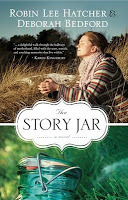 THE STORY JAR
THE STORY JARby Robin Lee Hatcher and Deborah Bedford
ABOUT THE BOOK:
A lovely novel of three women, their stories threaded together through the concept of
The Story Jar…
The jar itself is most unusual—not utilized in the ordinary way for canning or storing food, but as a collection point for memories. Some mementos in the jar—hair ribbons, a ring, a medallion--are sorrowful, others tender, some bittersweet. But all those memories eventually bring their owners to a place of hope and redemption in spite of circumstances that seemingly have no solution.
Fresh, insightful, yet courageous in the face of difficult life issues, this collaboration by two talented writers first profiles a pastor's wife with two young daughters who faces cancer just as her own mother did before her; and then a remarried mother working through a difficult relationship with a rebellious runaway daughter. The third woman, alone with two teenaged boys who no longer pay much attention to her and seem headed for trouble, discovers the long-lost "story jar" and its significance. She comes to realize she can bring her own sorrows and frustrations to the feet of the Good Shepherd, the Great Physician, the Healer of the brokenhearted. She too will have memories for her own story jar.
"…It captures with surprising sensitivity…communion with God, and some excruciatingly exquisite moments of parental love…" Publishers Weekly
Included in the book are heart-warming tributes on motherhood from novelists such as Jerry Jenkins, Francine, Rivers, Karen Ball, and Debbie Macomber.
************************
ABOUT THE AUTHORS:
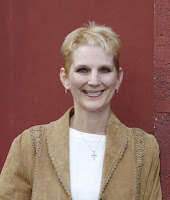
Robin Lee Hatcher is known for her heartwarming and emotionally charged stories of faith, courage, and love. She makes her home in Idaho where she enjoys spending time with her family, her high-maintenance Papillon, Poppet, and Princess Pinky, the kitten who currently terrorizes the household.

When Deborah Bedford isn't writing, she spends her time fly-fishing, cheering at American Legion baseball games, shopping with her daughter, singing praise songs while she walks along the banks of Flat Creek, and taking her dachshund Annie for hikes in the Tetons where they live.
********************
THE STORY BEHIND THE STORY JARby Robin Lee Hatcher
In September 1998, I received a story jar as a thank you gift after speaking at a writers' conference in Nebraska. The small mason jar, the lid covered with a pretty handkerchief, was filled with many odds and ends – a Gerber baby spoon, an empty thread spindle, a colorful pen, several buttons, a tiny American flag, an earring, and more.
The idea behind this gift was a simple one. When a writer can't think of anything to write, she stares at one of the objects in the jar and lets her imagination play. Who did that belong to? How hold was he? What sort of person was he? What does the object represent in his life?
Writers love to play the "what if" game. It's how most stories come into being. Something piques their interest, they start asking questions, and a book is born.
A week after receiving my story jar, I attended a retreat with several writer friends of mine, Deborah Bedford included. On the flight home, I told Deborah about the jar. The next thing you know (after all, what better thing is there for writers to do on a plane than play "what if"?), we began brainstorming what would ultimately become The Story Jar. We decided very quickly that we wanted this to be a book that celebrates motherhood, that encourages mothers, that recognizes how much they should be loved and honored.
The Story Jar was first published by Multnomah in 2000, but eventually went out of print. Thus Deborah and I are delighted that Hendrickson wanted to bring it out in a new, revised version because we believe these stories can inspire others, just as it did this reader back in 2001:
"I am an avid book reader and have read thousands of books––maybe more––since the age of 5. I can honestly say that [The Story Jar] has touched me more than any other I have read. I cried, I laughed, and I relearned things that I had forgotten long ago as well as realizing things I never knew. Thank you for sharing your stories with your readers. They are truly inspiring. I plan on giving it to all the 'mothers' in my life for Mother's Day."
You don't have to be a writer to want a story jar. It can be a family's way of preserving memories. Consider having a family get-together where everybody brings an item to go into the jar, and as it drops in, they tell what it means to them, what it symbolizes. We can learn something new about our loved ones when we hear their memories in their own words. Or do what my church did a number of years ago to create a memory for a retiring pastor. Inspired by The Story Jar, members of the congregation brought items to the retirement dinner to put into a story jar or they simply wrote their memories on a piece of paper to go into the jar. It was our way of saying thanks to a man and wife for all of the years they'd given in God's service.
A story jar can be a tool for remembering all the wonderful things God has done in our own lives. As Mrs. Halley said, not all of God's miracles are in the Bible. He is still performing them today in countless ways, changing lives, healing hearts.
In the grip of His grace, Robin Lee Hatcher
The Story Jar on Amazon:http://www.amazon.com/exec/obidos/ASIN/1598566652/novelistrobinlee
The Story Jar on ChristianBook:http://www.christianbook.com/Christian/Books/product?event=AFF&p=1138486&item_no=566659
Robin Lee Hatcherhttp://www.robinleehatcher.com
Deborah Bedfordhttp://www.deborahbedfordbooks.com/
April 4, 2011
The Thermodynamics of Writing

@font-face { font-family: "Cambria"; }p.MsoNormal, li.MsoNormal, div.MsoNormal { margin: 0in 0in 10pt; font-size: 12pt; font-family: "Times New Roman"; }div.Section1 { page: Section1; }
As happens so often when my husband and I have one of our many discussions, the topic inevitably touches on both science and writing. Of course I think it's far easier to talk about writing, because almost anyone can understand a story if it's told clearly enough. As far as science goes, I represent to my husband a sort of blank slate. If he can get me to understand certain segments of science then he can get just about anyone to understand them. I keep telling him I'm different from his students because I actually enjoy listening to him in particular, but I'm not sure that makes him feel any better.
Let me allow you a glimpse into one of our discussions. Not long ago, my husband was explaining to me the zeroth law of thermodynamics—actually I'd more accurately state that he demonstrated this law to me.
 I do not exaggerate when I say my husband has the coldest feet in the world, no matter the season or time of day. The two feet of snow depicted to the right is a fairly accurate representation of what my husband's feet feel like most of the time. On one very early morning, he was trying to warm his icicle toes by placing them under me, which I naturally resisted. In his attempt to divert my attention and succeed in stealing my warmth, he explained to me how his cold and my warmth would eventually even out and become the same. This is the zeroth law of thermodynamics. In this case such a law was working fine for him, but obviously not so fine for me.
I do not exaggerate when I say my husband has the coldest feet in the world, no matter the season or time of day. The two feet of snow depicted to the right is a fairly accurate representation of what my husband's feet feel like most of the time. On one very early morning, he was trying to warm his icicle toes by placing them under me, which I naturally resisted. In his attempt to divert my attention and succeed in stealing my warmth, he explained to me how his cold and my warmth would eventually even out and become the same. This is the zeroth law of thermodynamics. In this case such a law was working fine for him, but obviously not so fine for me.
But this is why my husband and I are so compatible, and incidentally why his diversion tactic worked. As he was explaining this scientific law, I began to forget about the glaciers trying to melt under me. It occurred to me I try doing something similar with every book I write. Here's how I explained the thermodynamics of writing to him:
An idea takes shape in my mind, and blossoms into a full-fledged story. But inside my head, it does nothing. (Quotes about a tree falling in the forest with no one around to hear it come to mind, but that's another topic altogether. Is a story untold really a story?) This as-yet-untold novel in my head is sort of like my warm feet. Then someone without a story comes along (i.e. with cold feet), and I share my story. My idea floats like energy between us, from my head to the reader's. It equals out between us.
The transmission of story energy is hopefully a far more pleasant experience than the exchange of heat between persons with warm and cold feet, but the idea is similar, at least to me as I tried to mesh science and writing in this discussion with my husband. When I tell my story to someone we share it equally. We're both inhabiting the same story world, you and I, the author and the reader, in the same way.
Okay, so I know this is a stretch. Science and writing don't have as much in common as I like to think, since I'm happily ensconced in a marriage with a steady exchange of ideas between my husband and I. Perhaps on a frosty morning having the warmth stolen from under me provided just the right conditions for this to make sense. Kind of like those middle-of-the-night epiphanies that by morning seem almost silly. But even now, this one makes me smile...
March 30, 2011
A Very Special New Fiction Wednesday

@font-face { font-family: "Cambria"; }p.MsoNormal, li.MsoNormal, div.MsoNormal { margin: 0in 0in 10pt; font-size: 12pt; font-family: "Times New Roman"; }div.Section1 { page: Section1; }
This week for New Fiction Wednesday, I want to share with you a special piece of fiction. As many of you know, I'm part of the Fragile X community. My son was born with this genetic disorder, which limits his development. While there are many things to worry about when someone you love so much has a disability, one of the blessings is the Fragile X community itself. There is immediate understanding of our experience, and nowhere else are our children more welcomed.
Another benefit is getting to meet other Fragile X moms, if not in person then via our Internet loop. One wonderful Fragile X mother recently posted a writing assignment she completed for her masters degree in Rehab Counseling. I was so moved by it I wanted to share it with you.
Assignment
You are presented with a metaphor. Think of a body of water as the path of life. Then consider a vessel on that body of water that has some disability. You are to describe how that vessel works its way through the water, starting where you desire but eventually reaching its goal. Be creative.
As completed by Nicole Ortiz:
In the Agape Archipelago every man and woman is given a vessel in which to travel when they reach a certain age. This is their rite of passage. They must take this from the far island in the east and drive it through to all the other islands to the far west. They may request a style, kind or color, but everyone gets what they receive and must take what is given.
 When it was Michelle's turn to get her boat, she was very excited. Many friends had gotten beautiful boats. Some were faster than others, streamlined and quick. Others had all the most advanced equipment and were the quickest to resolve any problems. These boats often skipped certain islands along the way through the Archipelago.
When it was Michelle's turn to get her boat, she was very excited. Many friends had gotten beautiful boats. Some were faster than others, streamlined and quick. Others had all the most advanced equipment and were the quickest to resolve any problems. These boats often skipped certain islands along the way through the Archipelago.
Michelle didn't get one of these. Hers was not the fastest. Hers was not the most streamlined or one of the ones with the most up to date equipment. In fact, hers had outdated equipment. Hers had no navigation. Michelle's boat was much slower than most of the other ones out there. Its engine sometimes stuttered and she'd have to take it in for overhauls regularly. She was given extra books for it and told there were some islands she would not be able to go to. University Island, they told her, was not a possibility. She would have to make frequent stops at Hospital Island and that meant going backward before going forward again. They would provide a tugboat for these trips, to assist when the engine sputtered and needed attention. If she was lucky, she'd make it to the golden island, but probably not passed ruby island. They told her there would be assistance and new guide book along the way and that if she couldn't handle the boat, she could always take it to Institution Island to stay.
Michelle was devastated by this and it took her a long time before she left the island. She looked at her new boat with a pain in her chest she did not quite understand and watched her friends all leave the main island one by one in their bright and shiny boats. Before she could take off, she had to learn a new way to navigate the world, by the stars. She had to learn when to recognize an engine sputter and how to measure the right fluids to make sure there wasn't a severe enough sputter to incapacitate the boat. Determined to prove them wrong, she set out on the boat.
It was a long, rough trip with several trips backwards to Hospital Island. Along the way she met many others, far more than she imagined with the same type of boats and learned new ways to navigate. She learned where the books were wrong and where they were right. She gained assistive technology in a compass and a means to communicate with the others who had boats like hers. Left behind by her friends, she gained new friends and new horizons. Family didn't often bring their boats alongside, but some did. Tugboats would help her back to the Hospital Island, sometimes almost too late before the boat would begin to sink. Waits were terribly long at the Hospital Island.
As time went on new technology was given to her and canals were widened to allow those that could not pass through them before to do so. Assistive technology for navigation, beyond a simple compass, became available. Teen island came and went, as predicted University Island was not available to her.
A different world was, though. One full of tug boats and people to help the boat through. Some boats like hers were good at tasks that many others couldn't be bothered with. These boats worked best in groups or with a tugboat along to aid them. This was a less glamorous and slower path than those who'd once been her closets and dearest. This path, however, was one able to stop and appreciate the fish in the water. On this path you could see the world change and sometimes be part of that change. Here, the sunsets and sunrises seemed more sweet and precious. It was a shorter, slower path than the others, but it had its own beauty within the tribulation: a sense of community in a world without love for those who are different.
Michelle's boat never made it all the way to the west. She was changed, forever, by the experience and while she grieved never having a fast boat, the trip with this one was not one she would have ever given up.
March 28, 2011
My Dream Writer's Weekend

@font-face { font-family: "Cambria"; }p.MsoNormal, li.MsoNormal, div.MsoNormal { margin: 0in 0in 10pt; font-size: 12pt; font-family: "Times New Roman"; }div.Section1 { page: Section1This past weekend was one of those times when life matched the starry-eyed expectations of being a writer. Since this doesn't happen very often (usually I'm doing laundry on weekends!) I thought the moments to be blog-worthy.
On Friday morning I received an almost unbelievable phone call from RWAs Liaison for the RITA contest who told me my book, Whisper on the Wind, is a finalist in this year's national contest. The RITA is like the Oscars of romantic fiction, one of the longest standing and most recognizable contests in the industry. Needless to say, it's quite an honor! So Friday and much of Saturday morning were spent between Facebook and email, basking in friendly notes of congratulations.

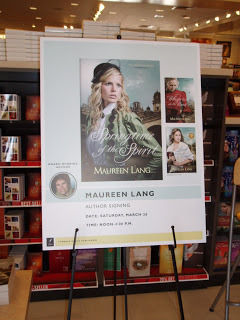 On Saturday afternoon, I had a book signing at the Johnsen & Taylor Bookstore in Wheaton, IL. Pictured below are several of the reasons I love writing for Tyndale. From left to right, Babette Rea, my Marketing Manager; Beth Sparkman, my cover designer; me; and on the far right is Maggie Rowe, my Publicist.
On Saturday afternoon, I had a book signing at the Johnsen & Taylor Bookstore in Wheaton, IL. Pictured below are several of the reasons I love writing for Tyndale. From left to right, Babette Rea, my Marketing Manager; Beth Sparkman, my cover designer; me; and on the far right is Maggie Rowe, my Publicist.
Believe me, these are not just people with dream job titles in a writer's life, these are dream people to work with! The event was like a party, all of us chatting and laughing. I did sign some books, but in between that Beth filled me in on many details I didn't know regarding my covers. For example, I didn't know the hat and brooch my heroine is wearing on the cover of Springtime of the Spirit actually belonged to my marketing manager's grandmother! And the pin in the hair of my heroine on Whisper on the Wind (pictured in the photo that's inside the front cover) belongs to my publicist. The books my heroine is holding in Look to the East, books representing ones she brings to the hero in hiding to help his days go faster, are old books from Beth's personal collection. Who knew? It was such fun to get a little behind-the-scene glimpse of how the covers are put together under Beth's creative direction. Of course, she extolled the talent of the Tyndale photographer (Stephen Vosloo) who did the shots and also took the background pictures in Europe. But it's Beth direction that puts the entire look together—from the lettering to the images. To me, she's a writer's hero! (Heroine!)
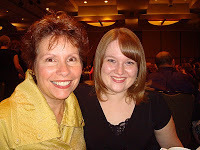 Another heroine who visited on Saturday was my line editor, pictured here at another event. (We were too busy chatting to remember to take more pictures!) My acquiring editor was out of town or she would have been there as well, making it a true Tyndale family affair. And reminding me how blessed I am to be working with so many people who love their job as much as I do. Great editors like these can make an author's work really shine – enough to final in the best contests!
Another heroine who visited on Saturday was my line editor, pictured here at another event. (We were too busy chatting to remember to take more pictures!) My acquiring editor was out of town or she would have been there as well, making it a true Tyndale family affair. And reminding me how blessed I am to be working with so many people who love their job as much as I do. Great editors like these can make an author's work really shine – enough to final in the best contests!
This week is spring break, so that means limited uninterrupted time for me to work on my current novel. But with memories of a weekend like this, I think I'm inspired enough to get some work done anyway. My family already knows what it's like to have a writer in the house . . .





